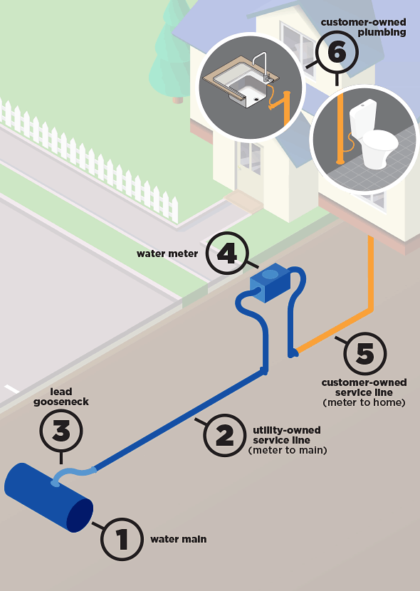Lead and Copper
Past Gooseneck Locations
Between 1900 and 1940, short pieces of lead pipe were sometimes used to connect the water main to customers’ service lines. These lead pipe segments often looked like a goose’s neck, and so are referred to as “lead goosenecks.” Over time, Tacoma Water removed 30,000 lead goosenecks while replacing old service connections.
Although we believe we had removed most of these lead goosenecks, there were still hundreds of old service connections for which we had no information. When these lines were installed, details about where lead goosenecks were installed were not recorded. Plus, because they are underground, they are difficult to verify.
In 2016, after reviewing paper records going back a century, along with multiple electronic records, we estimated the number of homes with possible gooseneck connections to be around 1,200.
Find and Replace Efforts
Some sections of Tacoma’s water system are so old that the installation of some service connections was not recorded at the time, which made it difficult to find lead goosenecks today.
We continued to search for additional records, and in 2016, we launched a five-year lead gooseneck replacement project budgeted at $10 million, which assumed replacing every service of an estimated 1,200 homes. The need to repave streets and repair sidewalks makes replacing a service expensive. During implementation, we determined our field personnel could dig a small hole over the service lines (potholing) to see if a lead gooseneck was present and if it needed replacing. By the end of the project, 418 of the potential goosenecks didn’t need replacement, which saved over $2 million. Coordinating other projects and partnering on paving contracts with the City of Tacoma Department of Public Works saved another estimated $2 million. We also retired or renewed about 428 service lines due to age that did not have a lead gooseneck attached. Ultimately, we found and removed only 342 lead goosenecks from the initial estimated 1,200. Thanks to efficiencies and due diligence, the total project cost came in under budget at about $6 million.
FAQs
- How can I test my water for lead?
-
If you are a Tacoma Water customer, we are happy to send you a free kit to test your water for lead. You can request you kit here. After you receive your kit, send it back to us with a water sample, at no cost to you for postage. We will then send it to a lab for testing and notify you of the results.
- Which water pipes do I own, and which belong to Tacoma Water?
-
We own the pipe from the water main to the water meter, so when the utility replaces a service, it is done up to the water meter. The pipe from the meter to the home belongs to you or the property owner.
This means the pipes on your side are usually the same age as the services the utility replaces, so they may not be in great condition. As a result, we recommend you have your pipe inspected by a plumbing professional so you are aware of their condition.

- How do you prevent lead from getting into people’s drinking water?
-
Lead in drinking water does not typically come from the water source. It usually comes from the plumbing leading to or inside your home. It is generally caused by the corrosion of plumbing or fixtures containing lead, or the solder that connects copper pipes.
To help prevent lead from getting into your water, we treat the water with caustic soda to raise the pH level (a measurement of acidity). Raising the pH makes it less corrosive on plumbing, reducing the amount of lead that can dissolve into the drinking water. In addition to the treatment at the Green River, we also provide corrosion control treatment for our seasonal groundwater well supply.
- What is Tacoma Water’s process for testing for lead, and who sets the rules?
-
The EPA’s Lead and Copper Rule sets the sampling methodology and acceptable levels of lead.
- How do high levels of lead in the water affect people?
-
Studies cited by the Environmental Protection Agency show that exposure to lead can cause health problems, especially in pregnant women and young children. Children are at highest risk of lead exposure from soil, dust, and paint in older homes. While drinking water is not usually a significant source of lead, it can contribute to total exposure.
- How does Tacoma Water report lead findings to customers?
-
The summarized results of the most recent round of lead sampling are included in our annual Water Quality Report that we mail to all customers each year.
- What type of homes run the highest risk of having lead contamination through the pipes?
-
Homes that were constructed prior to 1986 with copper plumbing and lead solder, or homes that contain any lead piping, are considered the highest risk.
- What can I do if I am concerned about lead in my water?
-
Along with requesting a free water test kit, we recommend you flush your pipes, by running the water for several minutes, if the water is shut off at the meter. It is also a good idea to flush pipes after prolonged periods without use, such as after a vacation.
- How can I determine whether my home has lead pipes?
-
We recommend you have your pipes inspected by a plumbing professional if you are concerned about its condition. More information regarding lead is available from the Environmental Protection Agency and the Washington State Department of Health.
- Who can I contact if I have concerns about my water?
-
If you have any questions or concerns about your water quality, our dedicated staff is ready to help. Please contact us at 253-502-8207 or waterquality@cityoftacoma.org.

